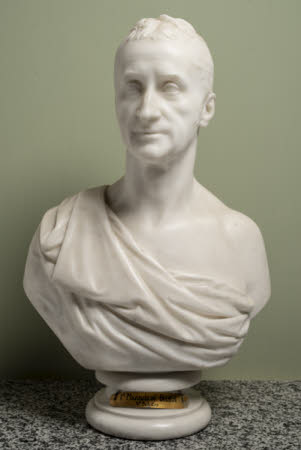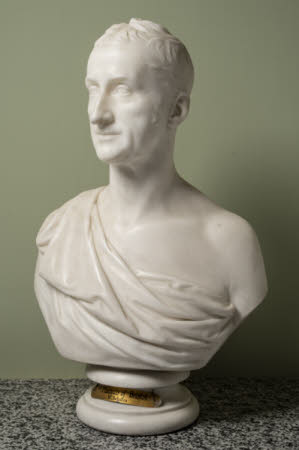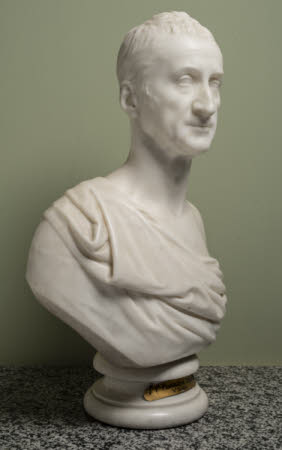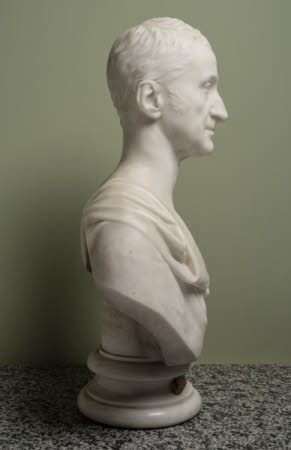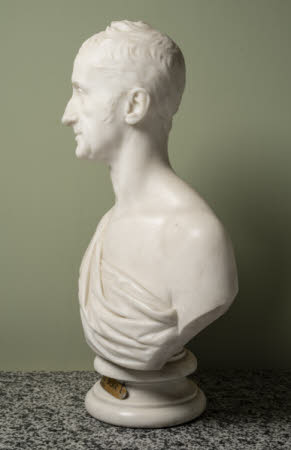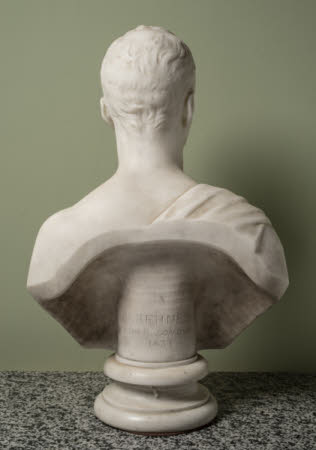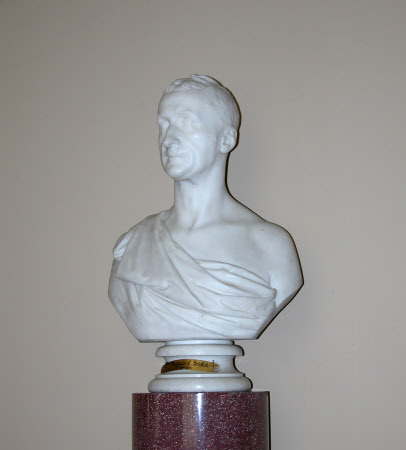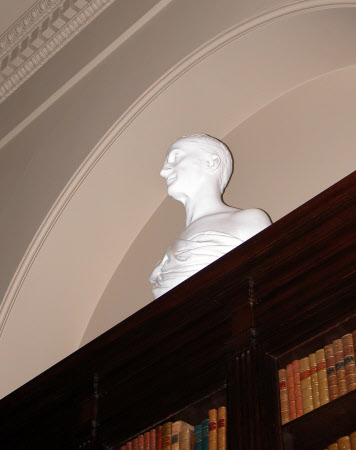Portrait bust of Frederick William Hervey, 5th Earl and 1st Marquess of Bristol (1769-1859)
William Behnes (London 1795 - London 1864)
Category
Art / Sculpture
Date
1833
Materials
Marble
Measurements
71 x 48 cm
Place of origin
London
Order this imageCollection
Ickworth, Suffolk
NT 852229
Summary
Sculpture, marble; Portrait bust of Frederick William Hervey, 5th Earl and 1st Marquess of Bristol (1769-1859); William Behnes (1795-1864); London, 1833. The second son of the 4th Earl of Bristol, known as the Bishop-Earl, Frederick William Hervey became heir to the title after the death of his elder brother. Sober and responsible, the 5th Earl rebuilt the wealth of the Bristol estates and completed the Rotunda at Ickworth, also acquiring much of the contents of the house. The sculptor of the portrait, William Behnes, was much admired by contemporaries for his skills as a portrait sculptor, but he had a difficult life and died in poverty. As well as this marble version, Behnes made several versions of the portrait in plaster.
Full description
A portrait bust in marble of Frederick William Hervey, 5th Earl and 1st Marquess of Bristol (1769-1859), the sitter shown with his left shoulder bare, a drape over his right shoulder and chest, looking to his right. Mounted on a turned marble socle and signed and dated at the back. Frederick William Hervey was the second son of Frederick Hervey, 4th Earl of Bristol (1730-1803), known as the Earl Bishop. Frederick William inherited the title of Earl of Bristol following the unexpected death of his elder brother John in 1796. As a young man, he had an extremely difficult relationship with his father who, when virtually cutting him out of his will in 1791, described him as ‘my undutiful and ungrateful son’. It may be that the Earl Bishop regarded his son as having in various disputes taken too much the side of his mother Elizabeth, with whom he was on hardly better terms. In 1796 Frederick again gravely disappointed his father, who had taken into his head that he should marry Marianne von der Marck (1780-1814), the illegitimate daughter of Frederick William II, King of Prussia and his long-standing mistress Wilhelmine Ritz, Countess Lichtenau (1752-1820), for whom the Earl Bishop had developed an infatuation. The hair-brained scheme was doomed, not least because the young Frederick was already in love with the Hon. Elizabeth Upton, eldest daughter of the Anglo-Irish courtier and peer, Clotworthy Upton, 1st Baron Templetown (1721-1785), whom he would marry in 1798. Ironically, the Earl-Bishop first met Wilhelmine in Munich in 1795, when she was travelling south to find distraction from the failure of a love affair that she had enjoyed in Berlin with none other than Elizabeth Upton’s brother John, later Viscount Templetown (1771-1846). Quite unlike his father, Frederick William Hervey proved to be a very normal person, a sober and reserved individual, who took his responsibilities as a landowner and as a family man seriously. He sat as MP for Bury St Edmunds from 1796 until 1803, when he entered the House of Lords. Reformist in his instincts, in 1807 Lord Bristol voted for the abolition of slavery. Whilst MP, he served as Under-Secretary of State in the Foreign Office, where his brother-in-law, the future Prime Minister Lord Liverpool, was then Foreign Secretary. It was thanks to Lord Liverpool that the Bristol Earldom would be raised to a Marquessate in 1826. When his father died in 1803, the ‘undutiful and ungrateful son’ received in addition to the entailed English estates only £1,000, whilst the Earl-Bishop’s huge fortune and Irish estates passed to a distant cousin. The new Lord Bristol worked hard in the coming years to restore the fortunes of his estates. It is largely thanks to him that Ickworth was not left a shell, the Rotunda being completed in 1821. Lord Bristol also set out to furnish the house appropriately on the Continental tour that he undertook with his family between 1817 and 1821, acquiring paintings and commissioning sculpture. In 1821 in Paris he bought back John Flaxman’s Fury of Athamas (NT 852233), the masterpiece that had been commissioned by the Earl Bishop and lost with the remainder of his collections during the Napoleonic invasion of Italy. Lord Bristol also commissioned a substantial part of the furnishings of Ickworth, including much furniture from the London makers Banting, France & Co. William Behnes has captured the serious and thoughtful nature of the 1st Marquess very well in this intelligently-conceived portrait, made when Lord Bristol was in his mid-sixties. The portrait must have been conceived in 1831, if the date on the version recorded in the 1950s at Bignor Park is correct. It may be that version that Behnes exhibited at the Royal Academy summer exhibition in 1832 (no. 1204). Whilst in some of his other works Behnes likewise leaves a shoulder bare, for example his portrait bust of Benjamin Disraeli at Hughenden (NT 429080), in the case of this portrait the use of this device serves to emphasise the vulnerability of the aging man. The portrait may be compared with the portrait bust of the same sitter as a much younger man, made by Lord Bristol’s mother-in-law Elizabeth Upton, Lady Templetown (1747-1823), perhaps around the time of his marriage to Lady Templetown’s daughter in 1798 (NT 852209). William Behnes was one of the finest portrait sculptors working in Britain in the first half of the nineteenth century, with a large studio through which many well-known sculptors passed early in their careers. The son of an immigrant German piano-maker and his English wife, Behnes moved with his family to Ireland at a young age, where his father struggled to make a living. In Dublin the young Behnes helped in his father’s workshop, but also attended the Dublin Society’s Schools, showing himself to be a gifted draughtsman. On moving back to London, where he is recorded exhibiting from 1815, Behnes at first practised as a portrait painter before changing direction to become a sculptor. He developed a flourishing business, especially in portraits, but he also made some fine church and public monuments. There are numerous sculpted portraits by him in National Trust collections. Behnes was praised for his portraits, the Art Journal stating with respect to his portrait bust of Thomas Clarkson, destroyed in the Blitz, that it had ‘never seen anything finer in modern or ancient art.’ (Art Journal, 1864, p. 83). However, much of Behnes' career was blighted by financial difficulties, which led him to drink and near-destitution. He died in 1863, having been found ‘literally in the gutter with threepence in his pocket.’ Other versions of the bust of Lord Bristol survive, two at Ickworth in plaster and signed but not dated (NT 852229.2 and NT 852236). Another plaster version, apparently neither signed nor dated, was in the sale of the contents of the East Wing at Ickworth in 1996 (Sotheby’s, The East Wing, Ickworth, Suffolk, 11-12 June 1996, lot 98). Yet another version of the bust, apparently signed 1831, was recorded at Bignor Park (Nares 1956, p. 863, fig. 12), whilst another versions signed and dated 1838 is said to have once been in the Bristol collections (Roscoe 2009). Jeremy Warren July 2025
Provenance
Part of the Bristol Collection. Acquired by the National Trust in 1956 under the auspices of the National Land Fund, later the National Heritage Memorial Fund.
Makers and roles
William Behnes (London 1795 - London 1864), sculptor
References
Nares 1956: Gordon Nares, ‘Bignor Park, Sussex’, Country Life, 26 April and 3 May 1956, pp. 860-63 and 924-27 Roscoe 2009: I. Roscoe, E. Hardy and M. G. Sullivan, A Biographical Dictionary of Sculptors in Britain 1660-1851, New Haven and Yale 2009
